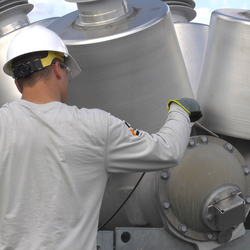New U.S. National Clean Hydrogen Strategy: Impact on the Gas Industry
The world needs more clean energy. One potential source is hydrogen gas, which we're familiar with in our industry. The U.S. National Clean Hydrogen Strategy and Roadmap is designed to encourage the development of hydrogen as an energy source. The Biden-Harris Administration announced its plan to accelerate clean hydrogen production, processing, delivery, storage, and use.
The roadmap aims to reduce economy-wide emissions by about 10% by 2050 and create 100,000 jobs by 2030. However, it's intended to be a living strategy that may change over time, reflecting demand, the development of new technologies, etc. What does this mean for the gas industry? For now, gas companies should prepare for increased demand for hydrogen and a potential gas industry transition away from methane.

Strategic Goals and Framework
The US national clean hydrogen strategy and roadmap contains strategic goals to maximize hydrogen production. Specifically, the goal is to produce and use 10 million metric tonnes (MMT) of clean hydrogen annually by 2030, 20 MMT by 2040, and 50 MMT by 2050. These values are based on the supply and the demand for clean hydrogen energy.
This means ramping up both production and demand. The cost of production will need to decrease, infrastructure will need to be improved, and the use of hydrogen needs to be encouraged. The framework targets strategic, high-impact hydrogen uses, including the industrial sector, heavy-duty transportation, and long-duration energy storage.
The gas industry will play a key role in reducing the cost of clean hydrogen production and improving mid-stream infrastructure, such as storage and distribution. The Hydrogen Energy Earthshot aims to catalyze innovation and encourage the scaling up of hydrogen production and distribution.
This will only work with demand increases, but as industry players realize the value of hydrogen, we will need to be ready to scale up. The Hydrogen Interagency Task Force is a collaboration that will involve the entire federal government in executing the hydrogen roadmap. The goal is to create a robust market with domestic supply chains.

Economic and Environmental Impact
The impact of the U.S. national clean hydrogen strategy and roadmap on the economy and the environment is promising. The 10% reduction in emissions is vital to the US's decarbonization strategy.
The Department of Energy's hydrogen roadmap aligns with its intention to reduce greenhouse gas emissions to half of 2005 levels by 2030, achieve 100% carbon-free electricity by 2035, and achieve net zero emissions by 2050. To achieve these ambitious goals, we need to leverage every possibility for decarbonization, including clean hydrogen energy.
The roadmap focuses on high-priority sectors that have few alternatives for decarbonization. Hydrogen is increasingly used to power fuel-cell forklifts, cars, and buses.
The hope is that hydrogen will be used more in the rail sector (for example, hydrogen fuel cells could be used to power trains through long tunnels in the west, greatly reducing the cost of electrification), the maritime sector, and in long-duration energy storage to help even out the natural volatility of renewables.
This will significantly reduce emissions in these energy-intensive sectors, clean the air, and slow climate change. Some innovations also offer the possibility of additional carbon sequestration, getting carbon out of the atmosphere.
Using hydrogen instead of methane or converting methane to hydrogen also reduces the amount of methane, a powerful greenhouse gas, released into the atmosphere.
Economically, the roadmap should create at least 100,000 good union jobs by 2030, with further employment generated over the ensuing decades. Many of these jobs will support the gas industry as the hydrogen economy develops.
People will work on building hydrogen infrastructure and developing improved techniques for green hydrogen production. The US hydrogen strategy will continue to grow and change over time as we discover which innovations are most effective for increasing production and reducing cost.
The Department of Energy's hydrogen roadmap will require extensive cooperation and coordination, but all gas companies can benefit from projects and subsidies that encourage infrastructure development and innovation.
Implications for the Gas Industry
The gas industry should be ready to enter the hydrogen sector. Hydrogen is a very light gas that requires particular effort to reduce leaks to a minimum. A proper fitting system is essential with existing pipe technology, especially for hydrogen applications, helium leak testing units, and high-pressure tube unions.
Technology monitoring hydrogen leaks and boil-offs must be improved and developed. Preserving hydrogen in storage and transit is key to reducing costs. Existing pipelines may need to be retrofitted to transport hydrogen or hydrogen/natural gas blends, which require different leak prevention strategies.
Liquefaction is another way to reduce boil-off. Surveys will also be done to find good sites for bulk hydrogen storage, including artificial sites such as mines or defunct oil wells.
Another area where the gas industry may have good opportunities is reducing the cost of high-pressure and liquid hydrogen storage tanks, especially carbon fiber composite vessels, which can be both efficient and lighter in weight. These are immediate opportunities for savvy companies that can pivot rapidly to an increased focus on hydrogen infrastructure.
Hydrogen rules will need to be followed to mitigate leaks and reduce waste. In the long term, regional hydrogen networks will be part of the DOE hydrogen roadmap.
Involvement in producing those networks could be lucrative but will require improved pipeline compressors, high-efficiency liquefaction designs, and low-cost regenerator systems.
Encouraging these innovations and developing a new clean hydrogen production standard is part of the US National Clean Hydrogen Strategy and Roadmap. We need to know what these new technologies will look like, what they will cost, and how to develop them best.
Another major challenge is that good places to produce hydrogen (for example, electrolysis sites need to be in areas with cheap renewables, such as a lot of wind) are often a long way away from sites of major hydrogen demand. There's also a hesitancy to commit resources due to longer-term risks.
Public awareness is another challenge. Most people don't know the potential of hydrogen or think that hydrogen fuel cells are worse than lithium batteries in EVs.
Policy and Incentives
Supporting the roadmap requires incentives. Two major laws provide for incentives. Through the Bipartisan Infrastructure Law, the DOJ enabled funds for $9.5 Billion Clean Hydrogen Initiatives to advance sustainable energy solutions. This includes $1 billion in the first phase to support research and development to reduce the cost of clean hydrogen production.
Companies that move quickly can benefit from these incentives both now and in the near future. Most of this money will be directed towards building Regional Clean Hydrogen Hubs, which will require infrastructure to support them, especially over the next couple of decades and into the long term.
Meanwhile, the Inflation Reduction Act included hydrogen production tax credits to encourage clean hydrogen production. For example, the Clean Hydrogen Production Tax Credit creates a 10-year incentive that gives a tax credit of up to $3/kilogram and up to 30% investment tax credit.
However, projects under this act had to start construction last year, but there are likely ongoing opportunities to support these projects as they move forward.
Future Outlook
If we're going to reach net zero by 2050, then that will require innovation in all sectors. Hydrogen plays a role in certain heavy-duty uses, primarily transportation and industry, and in energy storage. (For example, using extra renewables to produce hydrogen through electrolysis allows that energy to be stored and moved around.)
Achieving this will require collaboration between the public and private sectors. The U.S. National Clean Hydrogen Strategy and Roadmap is not enough on its own. Still, the industry needs to work with them, with tax credits and incentives, but it also needs to develop infrastructure and demand.
Gas companies must prepare for an evolving regulatory landscape and new clean hydrogen production, storage, and transportation opportunities. These opportunities can help future-proof your company and prepare you for a clean energy future.

DILO’s Hydrogen Solutions
To support this transition, DILO offers a range of innovative products for hydrogen applications, including high pressure tube unions, to ensure safety and reliability. The DILO sealing principle is perfectly suited for use in hydrogen applications due to its metal-to-metal seal (using no intermediate seal compound, such as an o-ring), which can be opened and closed as often as required while ensuring no emissions. By integrating DILO’s advanced gas-handling technology, companies can effectively contribute to a sustainable and hydrogen-powered future.
DILO's technology supports the hydrogen industry by providing advanced solutions for gas handling, promoting the safe and effective use of hydrogen as a clean energy source. By leveraging DILO's expertise and equipment, companies can integrate hydrogen into their operations, contributing to a sustainable energy future. Contact us to learn more.




